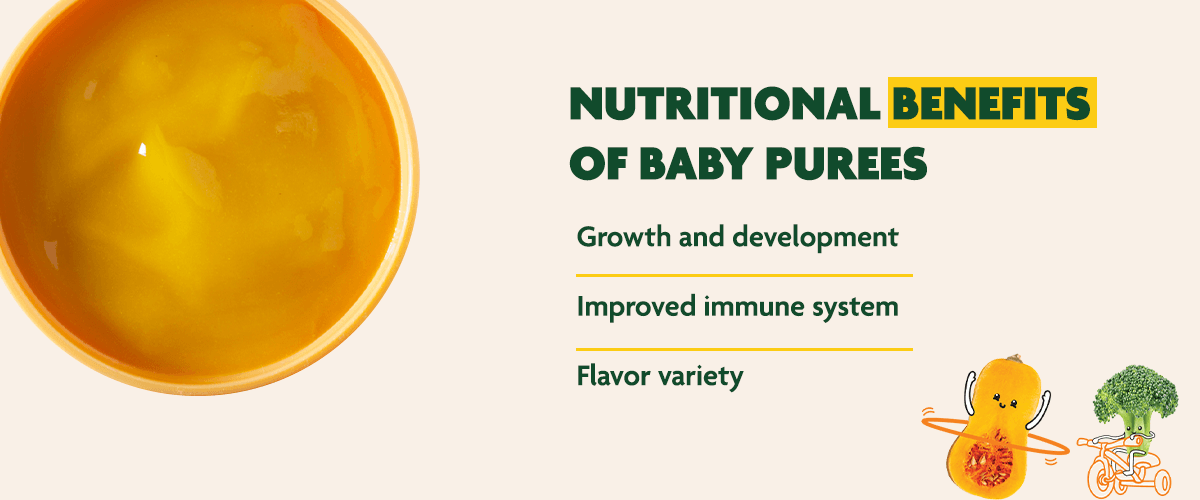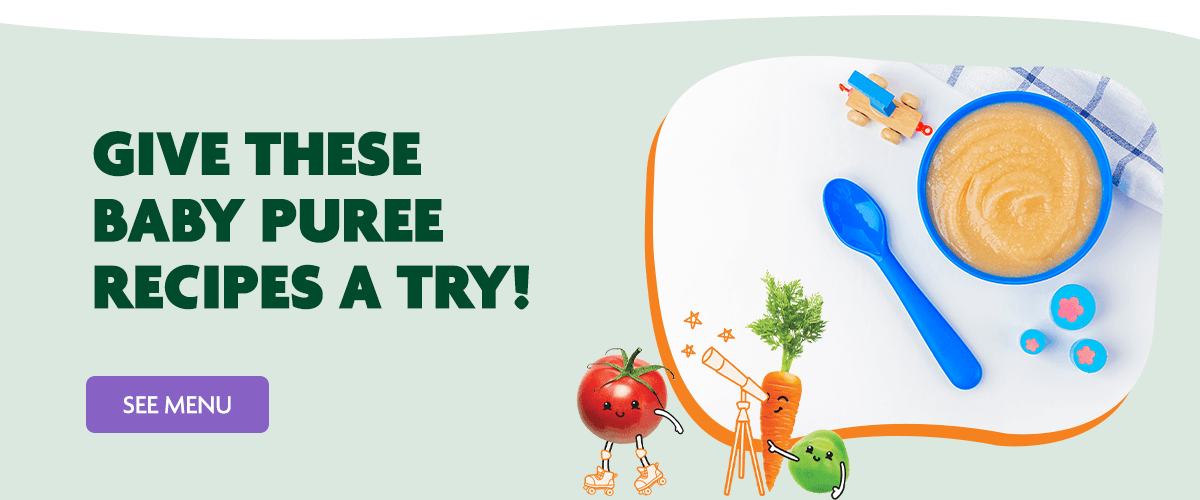10 of the Best First Baby Puree Recipes
Just finished your 4- or 6-month well-baby checkup and got the seal of approval to start solids from your pediatrician? If you and your baby are ready for Stage 1 purees, you’re both in for an exciting adventure. There are some amazing baby food purees out there with an endless variety of flavors!
When introducing solid foods to your baby, single-ingredient fruit and veggie purees are the best starter foods. Also called Stage 1 baby foods, these purees are served in addition to breast milk or formula and play several important roles for your baby, such as:
- Helping them adjust to something other than breast milk or formula
- Developing tongue control, gumming and swallowing capabilities
- Identifying any food sensitivities or allergies
- Encouraging an early acceptance of varied flavors, colors and textures
How to Know When Your Baby Is Ready for Purees
Introducing something new, like solid food, to your baby can be anxiety-inducing, especially when you’re not sure they are ready yet. At this point, you’re excited about moving the baby to the next stage, but if you do it too early, it could lead to serious risks like choking. According to the Centers for Disease Control and Prevention (CDC), you can typically introduce your baby to solid foods at four to six months. However, since each baby is different, there isn’t a strict rule that says you can’t begin earlier so long as your baby is past four months of age and is developmentally ready to try a new diet outside breastmilk and formula.
Within four to six months, you can look for developmental indications your little one is ready to try baby purees. Look out for these readiness signs:
- Sitting independently and demonstrating good head, neck and body control
- Learning to swallow and refraining from pushing food outward with its tongue
- Showing interest in your food and trying to grab it off your plate
- Managing to grasp items and trying to put them in its mouth
Nutritional Benefits of Baby Purees
Baby purees are a first-stage baby food, perfect for helping your little one explore new ingredients and develop eating skills. Here are some of the nutritional benefits of purees:
- Growth and development: Nutrient-rich purees contain essential vitamins and minerals for proper growth and development. Food purees containing vegetables, fruits, and animal products offer your baby a strong nutritional foundation as they continue to develop the motor skills needed to explore more diets.
- Improved immune system: Baby purees made from freshly sourced ingredients are free from chemical preservatives, which reduce the risk of allergic reactions. Additionally, puree’s high nutritional value can strengthen the baby’s immune system, helping them fight illnesses.
- Flavor variety: Babies are often picky eaters and can refuse certain flavors. Purees offer endless flavor options, from single flavors to different blends. The ease of turning various foods into baby purees allows your child to sample multiple flavors.

Our 10 Favorite Baby Puree Recipes
1. Carrot Puree
With a sweet taste and smooth consistency, pureed carrots are typically one of the most well-accepted first baby foods from 4–6 months of age. High in beta-carotene (which turns into vitamin A in the body), carrots help keep little eyes healthy.
Parent tip: If your baby doesn’t seem on board with the carrot puree, it may be the concept of solid food itself that’s confusing. Help your baby learn how to eat solids by giving them a chance to examine it themselves — dab some on the high chair and let them play around before offering it on a spoon.
2. Yam or Sweet Potato Puree
Sweet potatoes and yams are not the same, but when it comes to starting solids, they may as well be! Both are good sources of vitamin A, B6, C and E. These nutrients contribute to healthy eyesight and immune system function.
Parent tip: Yams and sweet potatoes are great to prepare in bulk. Simply set your oven to 450°F, pierce each sweet potato a few times with a fork and place in the oven on a baking sheet lined with aluminum foil for approximately 50 minutes. When you take them out, the skin will peel right off, and the insides will be perfectly mashable! To extend the life of your mash or puree, batch some out and put it in the freezer. When you’re ready to use it, simply place it in the fridge overnight, and you’ll have the perfect puree by morning.
3. Acorn or Butternut Squash Puree
Butternut squash and acorn squash are packed with folate, calcium and vitamin A, an antioxidant that aids with vision and fights free radicals. Plus, their sweet taste and smooth texture make them an instant favorite for many babies!
Parent tip: Make raw squash easier to cut by microwaving the entire squash on high for about 2 minutes. The skin and flesh will be much smoother, allowing you to slice through smoothly. Then scoop out the seeds and roast or boil them before pureeing.
4. Green Pea Puree
In terms of green veggies, peas are one of the best first baby purees to start with, as they provide interesting texture and taste but aren’t bitter. Peas are also high in vitamin A, vitamin C, vitamin K and protein, making them a great source of many important nutrients for your baby’s early development.
Parent tip: Because they’re such a starchy vegetable, even pureed peas may be too densely textured for very young babies. If your baby is having trouble with the thickness of the puree, use breast milk, formula or water to thin it out.
5. Green Bean Puree
Another hit with babies, green beans are a good source of vitamin K, vitamin C and manganese, which play an important role in a healthy immune system, eyesight, blood clotting and bone development.
Parent tip: If you’re pureeing your own green beans, we recommend straining the puree after blending to extract any fibrous parts. The best first baby purees should be soupy enough to drip off a spoon but thicker than liquid.
6. Avocado Puree
Avocados are rich in a variety of nutrients including fiber, vitamin K, folate and vitamin B6. This creamy green fruit is also packed with heart-healthy fats, which are helpful to your baby’s brain and nervous system development.
Parent tip: Look for ripe avocados that are soft to the touch and easy to mash. To see whether an avocado is ripe, check the nubby stem; if it wiggles, the fruit is probably ready to eat! Keep ripe avocados in the refrigerator so they last longer. Once the puree is made, we recommend feeding it to your baby right away to avoid browning and to offer the freshest experience.
7. Apple Puree
Apples’ sweet flavor makes them another well-accepted option for first baby foods from 4–6 months of age. Along with dietary fiber for digestive health, apples serve up vitamin C, which is known to help fight free radicals.
Parent tip: For an apple puree that your baby will love, try sweeter, smoother varieties such as Pink Lady, Gala or Golden Delicious. Any apple that bakes well, such as Granny Smith or Fuji, is also a good choice.
8. Pear Puree
Like apples, pears also contain dietary fiber and antioxidant vitamin C, helping to support a healthy immune system for your growing baby. Although our favorite is Anjou, babies love the sweet flavor of all kinds of pears!
Parent tip: To introduce a little variety without any added salt, sugar or seasoning, try mixing up how you cook the pears before pureeing. Start with a simple steam or boil and then move onto the richer, more caramelized flavor of baking or roasting.
9. Plantain or Banana Puree
The mild flavor of bananas and plantains is appealing to most babies, and the texture is easy to manipulate. Both of these fruits offer a variety of nutrients, including fiber for healthy digestion, potassium for blood function and antioxidant vitamin C.
Parent tip: Make your own easy banana puree by peeling, slicing and then mashing the fruit with a fork. For a thinner consistency, toss the banana in a food processor and add water, formula or breast milk as necessary.
10. Peach Puree
Boasting plenty of vitamins C and A, peaches are delightfully sweet and another one of the best first baby foods. Their bright yellow-orange color is complemented by powerful antioxidants along with a healthy serving of fiber to aid in your baby’s digestion.
Parent tip: Boil peaches for about 45 seconds to soften before blending. If the peaches are ripe enough, you can skip the boiling and the blender altogether and use a fork or potato masher instead.
6 Tips for Making Baby Purees
You can make the best first baby purees with our listed recipes, as they are simple and won’t take much time. However, before preparing puree for your baby, follow these tips to ensure your child’s first foods are clean, nutritious and safe:
- Before preparing baby food purees, wash your hands and clean the items you’ll be using, such as utensils, chopping boards and countertops.
- Scrub and wash produce, removing seeds and apparent fiber. With low-acid vegetables, take precautions to avoid food poisoning agents like Botulism.
- Cook, steam or microwave food until it’s tender. Before cooking, you want to remove skin, bones and extra fats from fish and meat products.
- Puree the food, adding its juices, water, breastmilk or formula until you get the desired texture for your baby. Since you’re introducing solid foods, start with a thin puree and adjust the texture as your baby adapts.
- To avoid food poisoning and Clostridium botulinum contamination, ensure eggs, meats, and poultry are well-cooked at appropriate temperatures. Since honey is highly likely to contain Clostridium botulinum spores that can make them sick, never add it to your baby’s food or drinks.
- For convenience, freeze baby food in small single-serving portions and store them in airtight food containers.
Give These Baby Puree Recipes a Try!
It may take some time for your little one to first accept and then enjoy the new flavors of these Stage 1 baby puree recipes, but don’t fret! Enjoy the process and be sure to give your baby multiple opportunities to explore the same puree.
Another reason that we love these fruits and veggies? In addition to being some of the best first baby purees, they’re also perfect for layering with new flavors, textures and spices/seasonings as your child transitions from Stage 1 to Stage 2 baby foods. By laying a foundation of well-accepted flavors, you’ll have fun moving onto more exciting combinations of fruits, veggies, grains and proteins with table foods.
Check out the healthy kid’s menu from Nurture Life online today.

